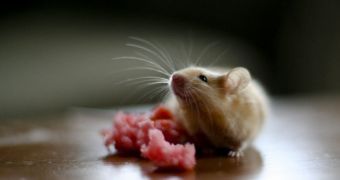In an interesting new finding, researchers determined that the area of the brain which enables mice to flick their whiskers when sensing an obstacle is not the one they thought it was. It would appear that the sensory, not motor, cortex is the main control center for this activity.
Investigators now believe that these conclusions could force a rethink of existing strict descriptions of certain brain regions and their specialized functions. Certain connections and mechanisms may have eluded studies thus far, some believe.
In mice, the motor cortex is responsible for controlling voluntary motions, such as for example when the rodent sees food and wants to head towards it. But its role apparently does not allow it to control the motion of whiskers.
“This study furthers the whole line of thinking about the brain – that really, all these systems are deeply interconnected,” explains Princeton University neuroscientist Michael Graziano.
“There’s a growing realization that it’s difficult to chop the brain up into little pieces and study them separately,” he goes on to say. This line of thinking underlines a paradigm shift taking place today, that affects the entire field of neuroscience.
The research was conducted by scientist Ferenc Matyas, who is based at the Hungarian Academy of Sciences in Budapest. Details appear in the November 26 issue of the top journal Science.
In the experimental setup the researcher and his team devised, they noticed that neurons in mice's sensory cortex were the first to get activated and fire electrical signals when the whiskers touched an object or obstacle.
Researchers believe that this area of the cortex is generally responsible for activities such as allowing the mouse to find a soft and warm nest, or sensing if the rodents get stuck in twigs or other obstacles.
In order to test for this correlation, the team used a toxin to inhibit activity in the sensory cortex of lab mice. They determined that the animals no longer flicked their whiskers when sensing an object.
Additionally, when the toxin was used to stop activity in the motor cortex, it was determined that the flicker was not influenced, provided that the sensory cortex wasn't in any way impaired.
“This was a big surprise because most people thought that the motor cortex is the one that controls voluntary movements and the sensory cortex is important for perception,” says Matyas, quoted by Science News.
Mice still use the motor cortex to direct their whiskers at objects of interest, but the sensory cortex underlies the reflex-like retractions and flickers. The motor cortex is activated as well, but after a few milliseconds.
“It’s a few milliseconds’ difference, but in neuronal processes, milliseconds mean a lot. Mice observe their environment through the whiskers,” Matyas says. As such, they may have had an evolutionary incentive to be able to quickly get away from danger.
The research also hints at a so-called brain region blurriness, in which signals traveling from one control area move faster than similar signals coming from another. This phenomenon could exist in humans as well, some experts believe.
“One needs breakthrough research like this to highlight for other researchers that such blurriness exists in principle. I think it is time to start looking at the cortex in a new, integrative way,” concludes University of California in Irvine expert Ron Frostig.

 14 DAY TRIAL //
14 DAY TRIAL //